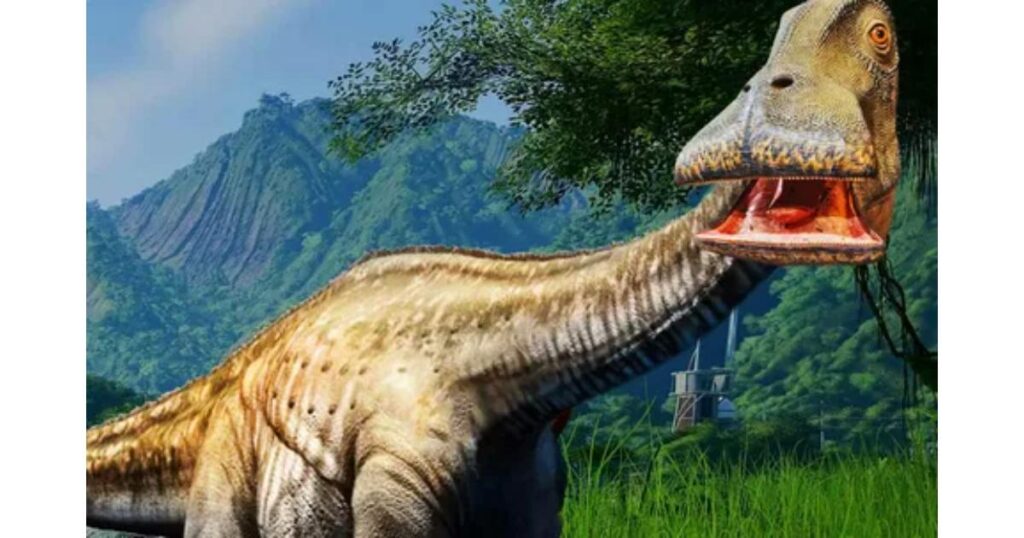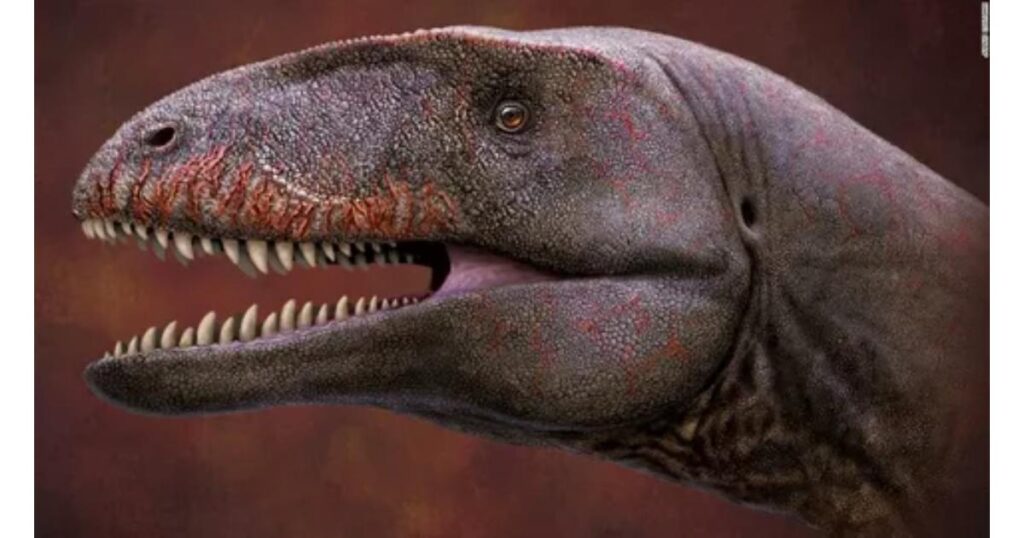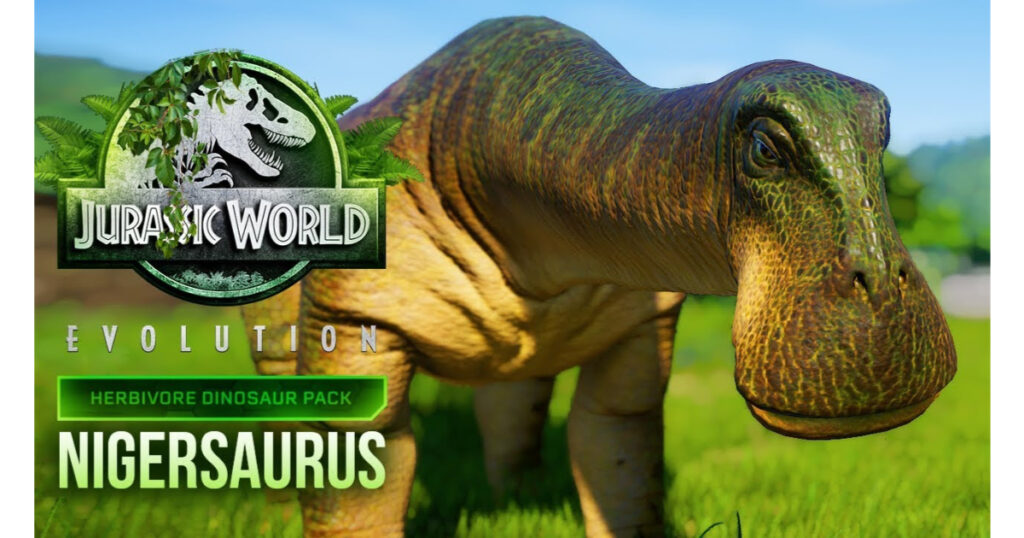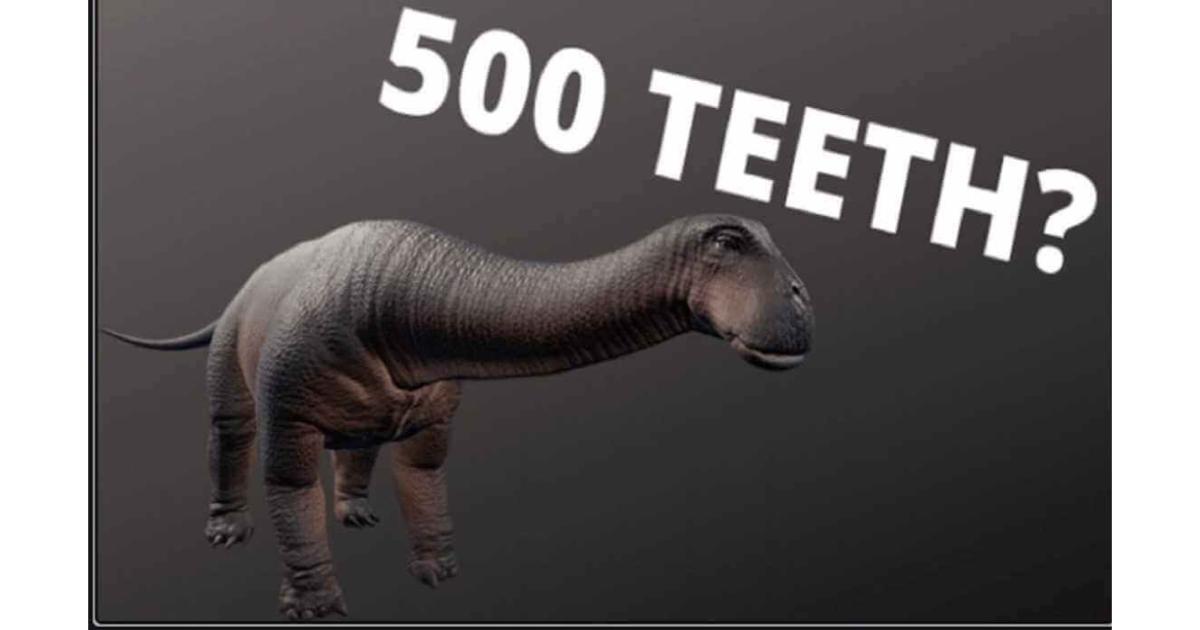The mysterious query of which dinosaurs possessed 500 teeth has captured the interest of both paleontologists and dinosaur enthusiasts. This extraordinary creature happens to be none other than the Nigersaurus. A plant-eating dinosaur that wandered through the terrains of present-day Niger during the middle Cretaceous era around 115 to 105 million years ago. Sporting a mouth filled with numerous small and sharp teeth arranged in rows upon rows, the Nigersaurus was uniquely suited to devouring its ancient habitat’s tender and plentiful vegetation.
The Nigersaurus earns its name “Nigers lizard” due to its features in the dinosaur world when it comes to eating habits. Its jaw resembles a vacuum cleaner, moving along the ground to feed. This unique trait enabled it to munch on much foliage to maintain its substantial body size. And, based on its teeth structure, with over 50 rows regularly replaced, it hints at a diet involving fern and horsetail consumption. I am making it an intriguing research topic to explore herbivory during the period.
Introduction to Nigersaurus: The Dinosaur with 500 Teeth

The Nigersaurus is a dinosaur-like creature famous for its remarkable teeth arrangement in its mouth region. They were living in the Cretaceous era added to its allure, as it sported a set of over 500 teeth. This unique characteristic nets the Nigersaurus apart and underscores the varied evolutionary changes dinosaurs embraced to flourish in their environments.
Experts suggest that the teeth of the Nigersaurus were not only plentiful but also uniquely suited to its plant-eating diet. The teeth were aligned in rows that facilitated the munching of low-growing plants. This physical feature reveals much about the dinosaurs’ eating behavior and their place in the ecosystem. It underscores how crucial it is to grasp life in times.
Read Also:Everything You Need to Know About Voting in Lok Sabha Elections
Exploring the Habitat: Where Did Nigersaurus Live?
The Nigersaurus used to wander the lands that now make up the Sahara Desert in Niger in the days of the Cretaceous era when this area teemed with life and diversity of plants and animals that offered a home for many different dinosaurs, like the Nigersaurus itself. The climate then was ideal for ferns and horsetails to thrive. These were probably part of what the Nigersaurus ate. What Dinosaur Has 500 Teeth?
Researchers examining the region have discovered proof backing a climate that slowly transitioned to a drier state over many years. Gaining insights into the environment of the Nigersaurus sheds light on the shifts in climate that Earth has undergone and how species have adapted to these changes. The fossil evidence from Niger offers information for scientists working to recreate ecosystems and the organisms they sustained.
Anatomical Wonders: The Unique Jaw Structure of Nigersaurus
The way the Nigersaurus’s jaws are built is truly remarkable, and it distinguishes it from other dinosaurs. Its jaws were broad, with a shape at the front and neatly arranged teeth perfect for munching on soft plants. Thanks to this mouth structure, the Nigersaurus could effectively be compared to herbivores with teeth for chewing tough plants.
The unique dental structure of Nigersaurus implies that it might have been one of the herbivores of its era—able to devour substantial quantities of plant matter rapidly to sustain its large physique. Its teeth structure and frequent replacement suggest an adaptation geared towards optimizing feeding efficiency and reducing tooth abrasions in harsh sandy conditions.
Dietary Habits: What Did Nigersaurus Eat with 500 Teeth?

The Nigersaurus mainly ate hanging plants by biting them with its square-shaped mouth and numerous teeth. It had teeth for breaking down plants, like ferns and flowering plants plentiful in its environment. The continuous renewal of its teeth was an adjustment for consuming rough plant materials.
The diet of Nigersaurus suggests its significance in the ecosystem as a consumer that influenced the plant life in its habitat. Studying Nigersaurus’s food preferences can offer knowledge about interactions during the Cretaceous era and shed light on plant diversity and distribution in that ancient environment.
Paleontological Discoveries: Unearthing the Nigersaurus Fossils
The uncovering of Nigersaurus fossils has played a role in broadening our knowledge of dinosaur diversity and the processes of evolution in the world. Initially found in Niger by French paleontologist Philippe Taquet in 1976, these fossil remains only revealed their significance when comprehensive specimens were discovered and studied by groups under the guidance of Paul Sereno, whose research between the 1990s and early 2000s shed light on Nigersaurus.
The analysis and further examination of Nigersaurus fossils have offered knowledge about its body structure and behavioral characteristics through research advancements in imaging methods such as CT scanning. These methods allow for exploring the details of the fossilized remains, which were previously unknown or obscure concerning skull features and tooth formations. The revelations shed light on the existence of the Nigersaurus while also adding to the conversations about dinosaur features and how they adapt to their environment.
Comparative Analysis: Nigersaurus vs. Other Herbivorous Dinosaurs

Compared to herbivores, like the Diplodocus and the Brachiosaurus, the dental and skeletal features of the Nigeraurus indicate diverse evolutionary routes taken by these creatures. While smaller than its relatives, the Nigeraurus boasted a mouth adept at feeding. This contrast reveals not only the adaptations of plant-eating dinosaurs but also emphasizes the vast biodiversity of ancient times, showcasing various strategies used to tackle environmental obstacles.
When examining the features of the dinosaur species Nigerosaurus, a plant-eating animal of its time, scientists understand how various herbivores shared resources and lived together without competing directly for food in ancient environments.
The Significance of Tooth Renewal in Nigersaurus
The ability of Nigersaurus to continuously renew its teeth was an advantage that helped it thrive in its environment. The frequent replacement of teeth meant that Nigersaurus always had a set for chewing and feeding – a vital necessity for a herbivorous creature like itself that relied on constant grazing for survival.
StudyingNigersaurus’se tooth replacement system helps us understand its feeding habits and provides insights into the evolution of vertebrate teeth. It sheds light on how ancient animals adapted to their habitats and compares these processes with contemporary species facing similar environmental challenges.
Technological Advances in Studying Fossilized Teeth
Lately, improvements have greatly improved our capacity to examine the preserved teeth of ancient creatures like Nigersaurus. Methods such as computerized tomography (CT) scans enable researchers to inspectteeth’e inside and outside structures without harming fragile fossils. This method doesn’t require procedures and offers many details about tooth structure, development patterns, and ways teeth wear down, all essential for comprehending how extinct species fed and what they preferred to eat.
Furthermore, these cutting-edge imaging methods have created opportunities in the field of studies by allowing for thorough analysis of petrified remains in their original locations. This ensures the preservation of a portion of the setting and authenticity of the fossil site, resulting in a precise depiction of the historical environments where these creatures lived and their interactions with their surroundings.
Nigersaurus in Popular Culture: From Science to Screen
Nigersaurus may not have the fame of T-Rex or Velociraptor, yet its distinct features are starting to grab people’s attention. Featured in documentaries and scientific conversations, the Nigersaurus has become a fascinating symbol of the unique and diverse world of dinosaur life. Its unusual appearance and feeding behaviors make it a popular subject for paleontologists and dinosaur fans interested in uncovering lesser-known facets of ancient times.
By captivatingly showcasing these dinosaurs in materials and media outlets, it’s possible to motivate young minds to take an interest in uncovering the enigmas of history while safeguarding natural history for future generations.
Conservation Lessons from the Past: What Nigersaurus Teaches Us About Biodiversity
When we delve into the world of dinosaurs such as Nigersaurus, we gain more than knowledge about creatures – we discover essential lessons about biodiversity and conservation efforts, too! The diverse characteristics and ecological functions of creatures like Nigersaurus demonstrate the nature of environments and underscore the significance of each species in upholding environmental harmony. This awareness emphasizes preserving biodiversity today to safeguard ecosystem stability and effectiveness.
The extinction events that led to the demise of dinosaurs, like the Nigersaurus, indicate how fragile life on Earth is when faced with global shifts in environmental conditions and adaptations over time.
FAQs
What is the name of the dinosaur with 500 teeth?
- The dinosaur known for having 500 teeth is called Nigersaurus.
When and where did the Nigersaurus live?
- Nigersaurus lived during the middle Cretaceous period, approximately 115 to 105 million years ago, in what is now the Sahara Desert of Niger.
Why did Nigersaurus have so many teeth?
- Nigersaurus had so many teeth that it could effectively graze on the lush, soft vegetation abundant in its ecosystem. Its mouth was adapted to sweep across the ground, allowing it to consume large amounts of plant material efficiently.
How did Nigersaurus use its teeth?
- Nigersaurus used its teeth to clip and chew soft vegetation. Its teeth were arranged in rows and constantly replaced, ensuring sharp teeth were always available for feeding.
What did the diet of Nigersaurus mainly consist of?
- DietNigersaurus’s diet mainly consisted of ferns, horsetails, and other low-lying soft plants common in its habitat during the Cretaceous period.
How was Nigersaurus different from other herbivorous dinosaurs?
- Nigersaurus was unique due to its vast mouth, which had numerous teeth, unlike other herbivores, which had teeth suited for crunching coarse vegetation. This adaptation made it specially equipped for grazing close to the ground.
What do we know about the physical appearance of Nigersaurus?
- Nigersaurus was a relatively small sauropod, about 9 meters long, with a short neck and a distinctive, wide mouth. Its head was also unique, with large nostrils and eyes positioned towards the top of its skull.
How do scientists study the fossils of Nigersaurus?
- Scientists use various modern technologies, including CT scanning and detailed fossil analysis, to study the structure of Nigersaurus’ bones and teeth, which helps them understand its feeding habits and lifestyle.
Has Nigersaurus been featured in any documentaries or exhibits?
- Nigersaurus has been featured in several paleontological documentaries and exhibits worldwide, highlighting its unique dental structure and lifestyle.
What can we learn from the life and extinction of Nigersaurus?
- Studying Nigersaurus helps scientists understand more about the ecosystems of the Cretaceous period and the adaptations of dinosaurs to their environments. It also provides insights into the impact of environmental changes on species extinction.
Conclusion
To sum up the discussion on the Nigersaurus—a dinosaur that may not be as widely recognized but is genuinely captivating—it showcases the range and adjustment of life forms. With its distinct dental setup comprising more than 500 teeth, this creature flourished in today’s Sahara Desert, effectively digesting soft plants that were challenging for other dinosaurs. This specialized trait highlights the creativity during the Mesozoic period and enhances our insight into dinosaurs’ interactions with their surroundings.
Studying Nigersaurus is an example of how intricate and changing ancient environments were. It offers essential and impovitalwledge of history and evolutionary mechanisms that influence life’s development here on Earth. Paleontology experts are constantly. Examining fossils; each find. Such as the discovery of the Nigersaurus. Contributes a part to understanding our planet’s biological legacy puzzle. These findings do not shed light on the past. It also provides valuable insights for the future. Exploring and researching these creatures helps expand our understanding and admiration for the beauty of nature and motivates generations to explore and protect our environment.
